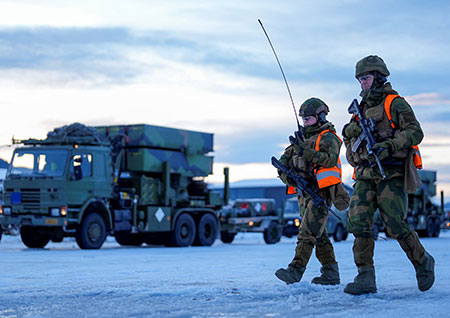
The Arctic member states of NATO demonstrate a clear commitment to the militarization of the region, which, in their opinion, may become the scene of future conflicts. On Wednesday, April 30, Norway is expected to complete a unique exercise designed to test the adaptation of personnel, military equipment and weapons to operate in conditions of extreme temperatures, lack of daylight and unpredictable weather conditions.
NATO in general and Norway in particular have concluded that not enough efforts are being made to adapt soldiers and equipment to the harsh conditions in the Arctic. Due to the temperature difference, automatic machines jam, radar installations fail due to severe snowstorms, and runways become unusable due to melting ice.
The harsh conditions of the Arctic have an impact on the morale of the military.
Unsurprisingly, the focus of the more than three months of exercises in northern Norway, which are due to end on Wednesday, is on honing survival techniques in extreme cold conditions.
13 Norwegian soldiers and military intelligence officers who went to the Far North on a mission to “test the effects of cold on the mind, body and equipment” were subjected to this test. Their task is to withstand temperatures of minus 37 degrees Celsius for 100 days, which is more than twice as long as previous military expeditions to this part of the country. At the same time, as Bloomberg clarifies, the exercises are the result of both “growing tensions in relations with Russia” and a change in the position of the administration of US President Donald Trump towards European allies.
“It’s like going to the moon. We don’t know what to expect,” the commander of the detachment told the agency.
At the same time, it became known that, in order not to freeze, the soldiers are dressed in multi-layered clothing, including woolen underwear. They travel on snowmobiles and skis, sleep on waterproof sheets, and use butter and meat from slaughtered deer in their diets. Due to the cold, the batteries in their night vision goggles run out, and the GPS malfunctions frequently.
Prolonged exposure to extreme cold has led to muscle stiffness and decreased manual dexterity, said Jorgen Melau of the Norwegian Armed Forces Joint Medical Service, who is one of a dozen scientists overseeing the experiment. “In such conditions, it is much more difficult to use your weapon or just zip up your jacket,” he explained.
Before starting the expedition, Melau took blood samples from the soldiers, measured their lung function and muscle mass. Halfway through, when they stopped in Norway’s northernmost Finnmark region for a three-day break, the tests were repeated. The tests will be performed again at the end of the experiment. About 75% of the results will be publicly available, and the rest will be shared with NATO allies.
As for the intermediate psychological tests, stress and lack of sunlight in the Far North have done their job. The participants in the experiment became excessively irritable, which led to quarrels.
During the exercises, the evacuation of victims was practiced, in the role of which volunteers from among the conscripts acted. The soldiers transported them on sleds behind their snowmobiles for 265 km for more than 50 hours. Based on the experience of combat operations in Ukraine, it was decided to abandon the use of helicopters for evacuation due to the high risk of being shot down.
The survival experiment in the Far North is a kind of response to the call of the commander of the Norwegian Armed Forces, General Eirik Kristoffersen, to “reliably deter Russia from attacking NATO” in the Arctic. Currently, about fifty military infrastructure facilities of NATO countries are located in the region. These include 22 airfields, 23 naval bases, bases, and four space and airspace surveillance radars. A network of eight radar stations is being created in Norway, and the first station is scheduled to enter service this year.
For its part, Moscow has repeatedly stated that it does not accept the introduction of confrontational approaches to the Arctic. Russia is interested in preserving the region as a zone of stability and predictability, and advocates building a reliable international security architecture in the Arctic Region that is equal for all Arctic states.
